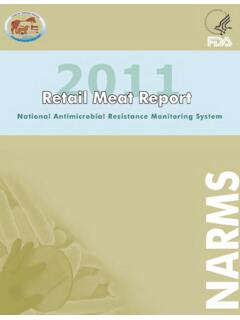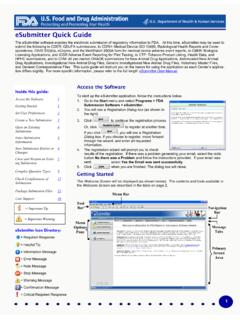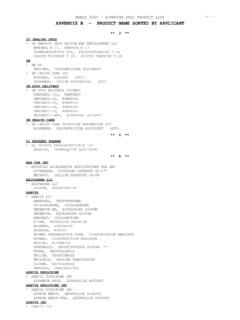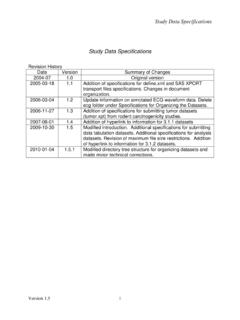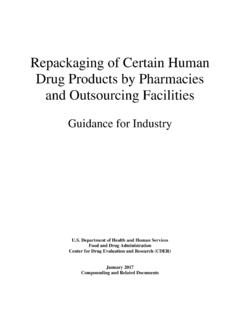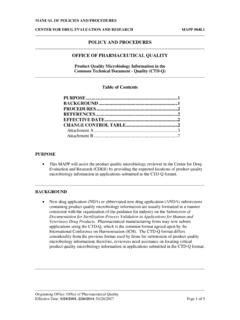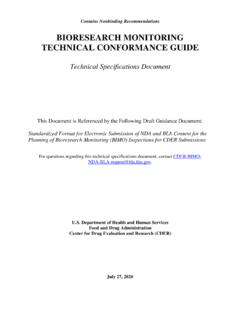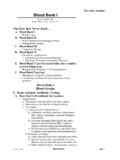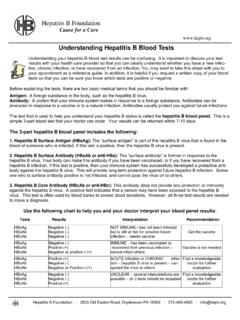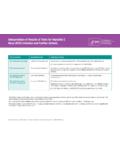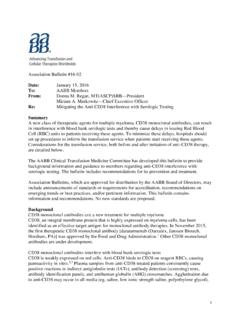Transcription of Guidance for Industry - Food and Drug …
1 Recommendations for Screening, Testing and Management of blood Donors and blood and blood Components Based on Screening Tests for Syphilis Guidance for Industry Additional copies of this Guidance are available from the Office of Communication, Outreach and Development (OCOD), 10903 New Hampshire Ave., Bldg. 71, Rm. 3128, Silver Spring, MD 20993-0002, or by calling 1-800-835-4709 or 240-402-8010, or email or from the Internet at ol og ics/ Guidance -compliance-regulatory-infor mation- biologics/biologics-guidances. For questions on the content of this Guidance , contact OCOD at the phone numbers or email address listed above. Depar tment of Health and Human Services food and drug Administration Center for Biologics Evaluation and Research September 2014 Updated December 2020 Contains Nonbinding Recommendations Recommendations for Screening, Testing and Management of blood Donors and blood and blood Components Based on Screening Tests for Syphilis _____ Guidance for Industry Note: Changes have been made to update the Guidance of the same title dated September 2014, including: Revised the recommended deferral period following treatment for syphilis or gonorrhea to 3 months; Added a recommendation for reentry of donors with false positive screening test results who are subsequently determined to have never had a diagnosis of syphilis.
2 Removed the recommendation for donors to provide written evidence of completion of syphilis treatment prior to reentry; Updated Code of Federal Regulation citations to reflect current requirements; and Made editorial or formatting changes. Contains Nonbinding Recommendations i Table of Contents I. 1 II. BACKGROUND .. 2 A. Transfusion-Transmission of 2 B. Testing of blood and blood Components for Syphilis .. 3 III. CHARACTERISTICS OF SEROLOGIC ASSAYS FOR SYPHILIS .. 4 IV. RECOMMENDATIONS FOR DONOR TESTING AND MANAGEMENT AND PRODUCT DISPOSITION WHEN USING TESTS FOR SYPHILIS .. 5 A. Identification of Donors with a History of Syphilis .. 5 B. Donor Testing and Management When Using a Nontreponemal Screening Test as the Test of Record for the Detection of Syphilis (See Figure 1) .. 6 C.
3 Donor Testing and Management When Using a Treponemal Screening Test as the Test of Record for the Detection of Syphilis (See Figure 2) .. 9 V. REFERENCES .. 12 Contains Nonbinding Recommendations 1 Recommendations for Screening, Testing and Management of blood Donors and blood and blood Components Based on Screening Tests for Syphilis Guidance for Industry This Guidance represents the current thinking of the food and drug Administration (FDA or Agency) on this topic. It does not establish any rights for any person and is not binding on FDA or the public. You can use an alternative approach if it satisfies the requirements of the applicable statutes and regulations. To discuss an alternative approach, contact the FDA staff responsible for this Guidance as listed on the title page. I. INTRODUCTION We, FDA, are providing you, blood establishments that collect Whole blood or blood components, including Source Plasma, with recommendations for screening and testing of donors and management of donations based on screening tests for syphilis.
4 Syphilis is a relevant transfusion-transmitted infection (Title 21 Code of Federal Regulations (CFR) (h)(1)(v)). Licensed blood establishments must report the implementation of the recommendations contained in this Guidance in accordance with 21 CFR This Guidance updates the Guidance of the same title dated September 2014. The September 2014 Guidance finalized the draft Guidance of the same title dated March 2013, and superseded the memorandum dated December 12, 1991, entitled Clarification of FDA Recommendations for Donor Deferral and Product Distribution Based on the Results of Syphilis Testing. In general, FDA s Guidance documents, including this Guidance , do not establish legally enforceable responsibilities. Inst ead, guidances describe FDA s current thinking on a topic and should be viewed only as recommendations, unless specific regulatory or statutory requirements are cited.
5 The use of the word should in FDA s guidances means that something is suggested or recommended, but not required. 1 Licensed blood establishment s that implement the revised recommendations for donor deferral and reentry provided in this updated Guidance document, dated December 2020, must report the changes to FDA in an annual report under 21 CFR (d), noting the date the process was implemented. Contains Nonbinding Recommendations 2 II. BACKGROUND A. Transfusion-Transmission of Syphilis Syphilis, caused by the spirochete Treponema pallidum (T. pallidum), is most often acquired after sexual contact with an infected individual. Syphilis can also be transmitted from mother to child or, rarely, transmitted by transfusion of blood or blood components from donors with active syphilis (Ref.)
6 1). The last reported case of transfusion-transmitted syphilis in the United States ( ) occurred in 1966 (Ref. 2). Universal testing of blood donors may have played a role in the disappearance of transfusion-transmitted syphilis. Other possible explanations for the decline in transfusion-transmitted syphilis include: that direct donor-to-recipient transfusions no longer take place; inactivation of T. pallidum (a cold-sensitive microorganism) in refrigerated blood components; the decline in rates of syphilis in the general population, which in turn is reflected in the donor population; self-deferral of blood donors who are ill during spirochetemia (presence of spirochetes the causative agent of syphilis infection in the circulating blood ); screening and deferral of potential donors who report high risk behavior for acquiring syphilis infection ( , persons who received money, drugs, or other payment for sex); wide use of antibiotics among transfusion recipients; and difficulties in diagnosing transfusion-transmitted syphilis in recipients (Ref.
7 3). However, none of these explanations has been quantified or adequately validated. Information from the American Red Cross on serological testing of donors revealed that there were 324 cases of syphilis infections among American Red Cross repeat allogeneic donors in 2007-2008, a figure several times higher than the numbers of repeat allogeneic donors identified with human immunodeficiency virus (HIV), hepatitis B virus (HBV), hepatitis C virus (HCV), and human T-cell lymphotropic virus (HTLV) infections, which were 92, 47, 127 and 9, respectively, during the same time period (Ref. 4). Several published studies (Refs. 5 through 9) that investigated the presence or absence of T. pallidum nucleic acid in blood samples from individuals with confirmed or possible syphilis detected spirochete nucleic acid in blood samples from persons with syphilis, some of whom had a latent infection with no symptoms.
8 Another study failed to confirm that finding (Ref. 10). This suggests that some asymptomatic blood donors might have spirochetemia. Donations from such blood donors might have the potential to transmit syphilis to recipients. Although syphilis testing has a low sensitivity and positive predictive value as a surrogate marker for detecting known transfusion-transmitted viruses, in 2009, the American Red Cross published data (Ref. 11) indicating that there were significantly higher rates of HIV-, HCV-, HBV-, HBsAg (hepatitis B surface antigen)-, and HTLV-positive donations among donors with positive syphilis test results compared to donors with negative syphilis test results. Contains Nonbinding Recommendations 3 B. Testing of blood and blood Components for Syphilis Current testing requirements for syphilis are found in 21 CFR (a)(2).
9 Individuals who test reactive2 with a screening test for syphilis must be deferred (21 CFR (a)) and notified of their deferral (21 CFR ). You must further test each donation found to be reactive by a donor screening test, except you are not required to perform further testing of a donation found to be reactive by a treponemal screening test for syphilis (21 CFR (e)). Additional testing to requalify the donor in accordance with (21 CFR (b)) is recommended in sections and C of this document. In accordance with (21 CFR (h)(2)(vi)), FDA allows use of blood and blood components, excluding Source Plasma, that test reactive by a screening test for syphilis, if the donation is further tested by an adequate and appropriate test which demonstrates that the reactive screening test is a biological false-positive and the blood or blood component is labeled with both test results.
10 Under 21 CFR (h)(2)(vii), you may use Source Plasma from a donor who tests reactive by a screening test for syphilis, if the donor meets the requirements of 21 CFR (b)(2). FDA requirements regarding syphilis testing specific to Source Plasma are as follows: 1. Current coll ection, testing and labeling requirements related to results of serologic tests are found in 21 CFR (b) and 2. A sample of blood must be drawn from Source Plasma donors on the day of the first medical examination or plasmapheresis, whichever comes first, and at least every 4 months thereafter, and these samples must be tested for syphilis (21 CFR (b)(1)(i)). 3. A donor with a reactive test result for syphilis must not be plasmapheresed again until the donor tests nonreactive, except as stated in points 4 and 5, below (21 CFR (b)(2)(ii)).
